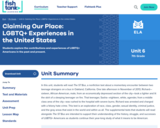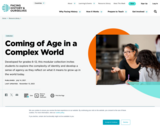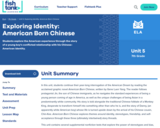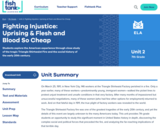How do epidemics begin and spread? How do human responses help or hinder during trying times? Can the way we think about medical outbreaks tell us anything about how we should think about human behavior? In this module, students explore epidemics in many forms: historical and current, medical and social. While students learn about the scientific investigation and medical intervention in these outbreaks, they also focus on the social and cultural responses to develop a model of how best to respond to challenging circumstances. Students also examine the ways that the concept of “contagion” is applied to human behavior and ultimately explore the question of why we behave the way we do.
In Unit 1, students begin exploring the history of medical epidemics and focus on people’s mindsets and contributions, and how they behaved differently from those around them. Students define what a medical or biological epidemic is, answering questions such as: what characteristics do the large-scale disease outbreaks that we refer to as epidemics have in common, and how do they spread? Exploring these foundational questions about epidemics and the people who “fought” them provides the conceptual scaffolding and some of the terminology necessary for extending the study of medical epidemics to social epidemics in Unit 2. Students read three chapters from the anchor text, Patient Zero, examining the wide variety of text features and structures incorporated in each chapter of Patient Zero, as well as how major sections contribute to the whole text and the development of ideas. Students also practice determining the meanings of words and phrases, especially technical terms associated with epidemiology. In the second half of the unit, students focus more on the interactions between the individual epidemiologists or scientists, the events during the epidemics, and the ideas about disease at the time, as well as consider the mindsets, tools, and character traits that enabled the scientists to solve these medical mysteries. Students also practice determining the impact of word choice on meaning and tone.
In Unit 2, students transfer the knowledge about how scientists think about and investigate medical epidemics to the study of social epidemics. Students are introduced to the topic of social epidemics through various articles which describe the basic terms and theories behind social and emotional contagion. They analyze the articles both for central ideas and argument in order to evaluate whether the authors of an article have provided sufficient evidence and reasoning for their claims connecting social and disease epidemics. Students respond to the broader question of how learning from social epidemics is applied to medical epidemics both in formal discussion and informative writing.
In Unit 3, students begin by listening to exemplar podcasts and reading a model podcast script about epidemics and how people responded to them. They analyze what makes these podcasts strong and build criteria for success based off of their observations. Using these models as a template, students embark on researching an epidemic of their choosing. They gather research around the epidemic stories, toolkit, character traits, and message. In triads, students plan, write, and revise a narrative nonfiction podcast script. For their end of unit assessment, students present their script, focusing on coherence and organization of information, volume, eye contact, clarity, and formal, conventional English. Next, they find sound effects, and then finally, they record and splice together the podcast. In the end, they have a podcast created with craftsmanship to publish for their classmates, school, or even the world.
Please note that students do not read about the COVID-19 pandemic in the assigned reading in this module; however, there are references to this pandemic in some of the chapters in Patient Zero. For those students who may wish to research the COVID-19 pandemic in Unit 3, there is an entire chapter in Patient Zero dedicated to this topic.





